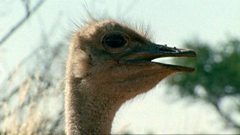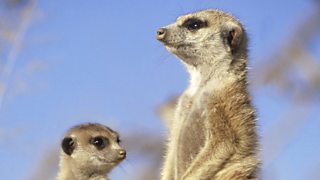
Seoc an Struth/Ollie the Ostrich
This episode features Ollie, an ostrich living in the Etosha National Park and who hatched from the world's largest egg.
Sreath a tha a' toirt thugainn fiosrachadh a tha inntinneach agus iongantach mu chuid de na h-ainmhidhean as fhe脿rr leinn. An-diugh tha sinn a' coinneachadh ri Seoc, struth a tha a' fuireach ann am P脿irce N脿iseanta Etosha.
Th脿inig e 脿s an ugh as motha air an t-saoghal - uimhir ri 24 uighean circe. Ann an seo, tha e tric os cionn 40 puingean de the貌thachd agus bha aig mam ris na h-uighean a ghur gus an cumail fuar. Chuidich dad ge-t脿. Tha esan m貌r, mu 2.74 meatair a dh'脿irde.
Rug m脿thraichean eile an uighean san aon nead agus faodaidh aon mh脿thair a bhith coimhead 脿s d猫idh suas ri 60 isean. Tha s霉ilean nan struthan nas motha na an eanchainnean: ch矛 iad air an c霉laibh gun an ceann a thionndadh. Ach nuair a dh'fh脿sas e suas, ruithidh Seoc aig 70 cilemeatair san uair is th猫id e 8 meatairean le aon cheum.
Investigative guides which reveal amazing facts about members of the animal kingdom. Today's location is Etosha National Park and the focus is on Ollie, an ostrich who emerged from the largest egg in the world.
In this part of Africa, the temperature is often over 40C and mum had to brood the eggs to keep them cool. Dad helped out, too. He is an impressive 2.74 metres tall. Other mothers laid their eggs in the shared nest and one mother could end up caring for as many as 60 chicks.
Creches of chicks may get to be as big as 300. Ostrich eyeballs are bigger than their brains; they can see behind themselves without turning their heads. Their feathers do not have the little barbs that join them together, like normal flight feathers. That is why they look so light and fluffy. But when full-grown, Ollie will run at 70 kilometres an hour and cover over eight metres in a single stride.
Last on
Clip
-
![]()
Fiosrachadh inntinneach mun t-struth
Duration: 01:37
Broadcasts
- Mon 28 Apr 2014 18:40
- Fri 2 May 2014 18:20
- Sat 3 May 2014 18:55
- Mon 28 Jul 2014 19:10
- Wed 30 Jul 2014 19:10
- Wed 3 Feb 2016 18:10
- Sat 6 Feb 2016 18:15
- Sun 7 Feb 2016 18:05
- Tue 22 May 2018 19:30
- Thu 24 May 2018 19:30
- Tue 21 Apr 2020 18:35
- Mon 20 Jul 2020 18:35
- Fri 11 Jun 2021 18:00
- Fri 17 Jun 2022 18:00
- Fri 30 Jun 2023 18:00
- Sat 1 Jul 2023 17:00
Featured in...
![]()
Aithne air Ainmhidhean
Investigative guides revealing amazing facts about our favourite animals.


